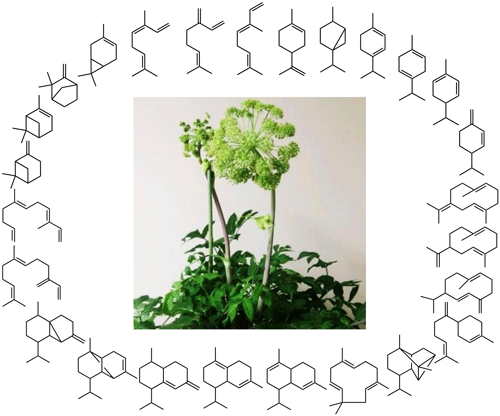- 著者
- Miki Suenaga-Hiromori Daisuke Mogi Yohei Kikuchi Jiali Tong Naotsugu Kurisu Yuichi Aoki Hiroyuki Amano Masahiro Furutani Takefumi Shimoyama Toshiyuki Waki Toru Nakayama Seiji Takahashi
- 出版者
- Japanese Society for Plant Biotechnology
- 雑誌
- Plant Biotechnology (ISSN:13424580)
- 巻号頁・発行日
- vol.39, no.4, pp.391-404, 2022-12-25 (Released:2022-12-25)
- 参考文献数
- 33
- 被引用文献数
- 1
Angelica archangelica L. is a traditional medicinal plant of Nordic origin that produces an unusual amount and variety of terpenoids. The unique terpenoid composition of A. archangelica likely arises from the involvement of terpene synthases (TPSs) with different specificities, none of which has been identified. As the first step in identifying TPSs responsible for terpenoid chemodiversity in A. archangelica, we produced a transcriptome catalogue using the mRNAs extracted from the leaves, tap roots, and dry seeds of the plant; 11 putative TPS genes were identified (AaTPS1–AaTPS11). Phylogenetic analysis predicted that AaTPS1–AaTPS5, AaTPS6–AaTPS10, and AaTPS11 belong to the monoterpene synthase (monoTPS), sesquiterpene synthase (sesquiTPS), and diterpene synthase clusters, respectively. We then performed in vivo enzyme assays of the AaTPSs using recombinant Escherichia coli systems to examine their enzymatic activities and specificities. Nine recombinant enzymes (AaTPS2–AaTPS10) displayed TPS activities with specificities consistent with their phylogenetics; however, AaTPS5 exhibited a strong sesquiTPS activity along with a weak monoTPS activity. We also analyzed terpenoid volatiles in the flowers, immature and mature seeds, leaves, and tap roots of A. archangelica using gas chromatography-mass spectrometry; 14 monoterpenoids and 13 sesquiterpenoids were identified. The mature seeds accumulated the highest levels of monoterpenoids, with β-phellandrene being the most prominent. α-Pinene and β-myrcene were abundant in all organs examined. The in vivo assay results suggest that the AaTPSs functionally identified in this study are at least partly involved in the chemodiversity of terpenoid volatiles in A. archangelica.
- 著者
- Junichirou Ohzeki Kazuto Kugou Koichiro Otake Koei Okazaki Seiji Takahashi Daisuke Shibata Hiroshi Masumoto
- 出版者
- Japanese Society for Plant Biotechnology
- 雑誌
- Plant Biotechnology (ISSN:13424580)
- 巻号頁・発行日
- vol.39, no.2, pp.101-110, 2022-06-25 (Released:2022-06-25)
- 参考文献数
- 55
- 被引用文献数
- 2
Genome information has been accumulated for many species, and these genes and regulatory sequences are expected to be applied in plants by enhancing or creating new metabolic pathways. We hypothesized that manipulating a long array of repetitive sequences using tethered chromatin modulators would be effective for robust regulation of gene expression in close proximity to the arrays. This approach is based on a human artificial chromosome made of long synthetic repetitive DNA sequences in which we manipulated the chromatin by tethering the modifiers. However, a method for introducing long repetitive DNA sequences into plants has not yet been established. Therefore, we constructed a bacterial artificial chromosome-based binary vector in Escherichia coli cells to generate a construct in which a cassette of marker genes was inserted into 60-kb synthetic human centromeric repetitive DNA. The binary vector was then transferred to Agrobacterium cells and its stable maintenance confirmed. Next, using Agrobacterium-mediated genetic transformation, this construct was successfully introduced into the genome of cultured tobacco BY-2 cells to obtain a large number of stable one-copy strains. ChIP analysis of obtained BY-2 cell lines revealed that the introduced synthetic repetitive DNA has moderate chromatin modification levels with lower heterochromatin (H3K9me2) or euchromatin (H3K4me3) modifications compared to the host centromeric repetitive DNA or an active Tub6 gene, respectively. Such a synthetic DNA sequence with moderate chromatin modification levels is expected to facilitate manipulation of the chromatin structure to either open or closed.
